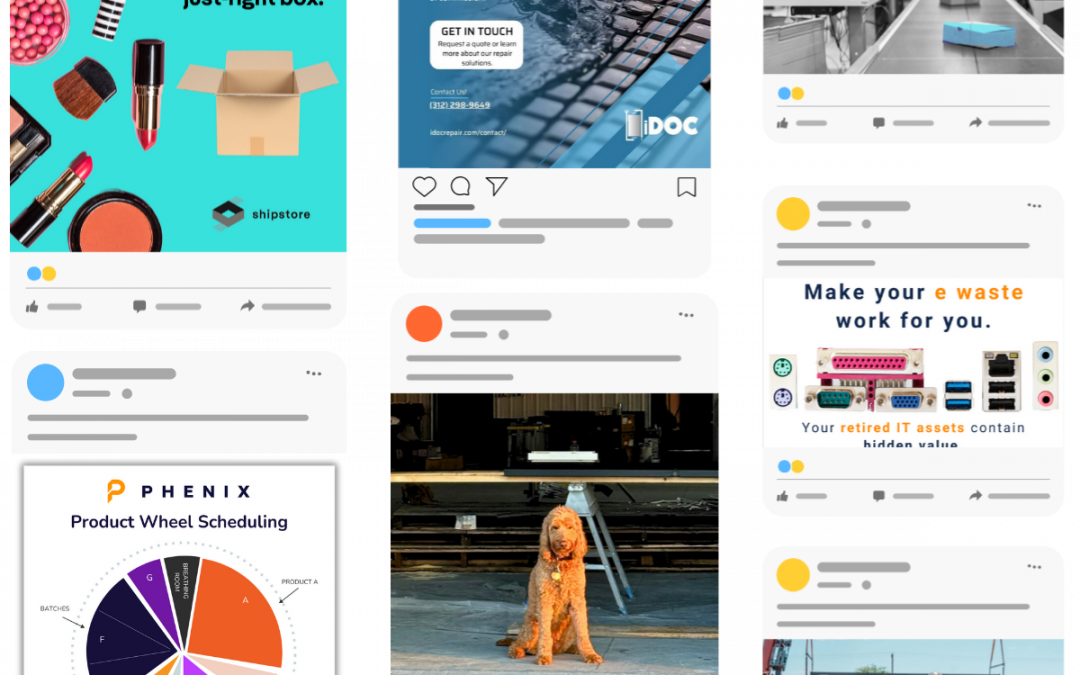
by Fronetics | Jun 15, 2016 | Blog, Marketing, Strategy

B2B organizations are leveraging review sites to increase organic traffic and conversion rates. Here’s how.
Consumers regularly turn to review sites to research products and services before they buy. But did you know that businesses can leverage this behavior to increase organic traffic and drive conversions?
B2B organizations are joining third-party review sites precisely for benefits like these. In fact, such memberships are becoming an integral part of some marketing strategies.
Let’s take a look at it works.
Review sites inform buying decisions
Buyers value the opinions of peers and colleagues. In fact, B2B buyers rank it among their top three resources for information about solutions, along with experts and web searches.
It makes sense: User reviews offer an unbiased, credible experience regarding a company’s product or services, so potential customers do not have to rely exclusively on information the organization provides. What’s more, reviewers often share more than just opinions; they frequently include related tips or good-to-knows, which offer extra value for the reader.
Experts equate review sites to short-form versions of case studies, which 83% of B2B buyers report as important when comparing vendors. Reviews offer real-life experiences with the product or service, but are much quicker to read and easy to consume in aggregate than case studies. They are also written from a buyer’s perspective, which resonates much more than, say, technical language and specifications.
Value for businesses
More succinct than a case study and just as credible, user reviews offer compelling testimonials that can attract customers at any point in the buying cycle. Here are a few ways organizations can leverage them to their advantage.
1) Use them as content.
Reviews make excellent lead-nurturing content. A business could share a positive review on social media or integrate it into a blog post. Negative reviews, too, give an organization a chance to address questions or concerns through content. Either way, reviews give insight into what customers are talking about, and this can help inform your content strategy.
2) Build brand awareness.
As more buyers turn to review sites to research products, companies who are members of the review site benefit from having their name in the mix. Even if a potential customer is researching a competitor, that person will likely come across your business name in comparison. That kind of exposure is invaluable as buyers are actively creating their vendor short lists — especially if you have very positive reviews.
3) Build customer trust.
Participating on a business-review site promotes the transparency customers crave. It tells them you are willing to let your customers share the bad as well as the good for all to see. Additionally, positive reviews can boost an organization’s Google seller rating, which appears next to the business name in AdWords ads. The seller rating gives readers insight into how the business rates for quality service before that person ever visits the website and, if the rating is high, establishes instant credibility. And more credibility equals more click-throughs.
4) Increase organic traffic.
Search engines favor reviews, meaning search engine algorithms increase the search ranking of sellers who have favorable ratings on review sites. Consider that 60% of organic clicks go to the top three search results, and that the vast majority of readers won’t search beyond the first page of results. Any boost from positive reviews can increase your organic traffic potential.
5) Drive conversions.
Many organizations are finding reviews enormous valuable for their business in the late stages of the buyer’s journey. Password-management startup Dashlane, for example, reported a 14.5% increase in conversion rates when reviews were added to paid ad landing pages. Because reviews hold such credibility and resonate so strongly with customers, they make for excellent closing content.
Here are a few B2B review platforms to consider joining as part of your marketing strategy.
- G2 Crowd: Offers online reviews on B2B marketing services as well as business software.
- GetApp: Allows users to search for industry topics as well as specific products.
- IT Central Station: Described as a “Yelp or TripAdvisor for enterprise technology.”
- TechnologyAdvice: Allows users to perform side-by-side comparisons of solutions within a particular category.
- Trustpilot: A community where users can interact with one another regarding particular solutions they use.
- TrustRadius: Authenticates each reviewer and validates every review through its research team prior to publishing.
Related posts:

by Elizabeth Hines | Jan 22, 2025 | Marketing, SEO, Website Development
In a fiercely competitive market, standing out in search results is crucial for any supply chain website’s success. One powerful yet often overlooked tool in the SEO arsenal is FAQ schema markup. This guide will dive deep into what FAQ schema markup is, why it matters, and how to implement it effectively to enhance your search visibility.
In this post:
What is FAQ Schema Markup?
FAQ schema markup is a code snippet that helps search engines understand that a particular section of your webpage contains frequently asked questions and answers. When implemented correctly, it enables your content to appear in rich results on Google’s search engine results pages (SERPs), potentially displaying your FAQs directly in the search results.
This enhanced visibility can significantly increase your click-through rates and establish your website as an authoritative source of information in your industry.
Why Should You Implement FAQ Schema?
The benefits of implementing FAQ schema markup extend beyond just improved visibility:
1. Enhanced SERP Real Estate: Your content can occupy more space in search results through rich snippets, pushing competitors further down the page.
2. Improved User Experience: Users can find answers to their questions directly in search results, leading to better engagement when they click through to your site.
3. Voice Search Optimization: FAQ schema markup makes your content more accessible to voice search queries, an increasingly important factor in modern SEO.
4. Higher Click-Through Rates: Rich results tend to attract more clicks than standard search results, potentially driving more traffic to your website.
How to Create FAQ Schema Markup
Creating FAQ schema markup involves structuring your data in a way that search engines can understand. Here’s a step-by-step guide:
Step 1: Prepare Your FAQ Content
Before implementing the schema, ensure your FAQ content is well-organized and valuable to users. Each question should have a clear, concise answer that provides genuine value.
Step 2: Generate the Schema Code
Your FAQ schema should follow this basic structure:
“`json
{
“@context”: “https://schema.org”,
“@type”: “FAQPage”,
“mainEntity”: [{
“@type”: “Question”,
“name”: “What is your first question?”,
“acceptedAnswer”: {
“@type”: “Answer”,
“text”: “This is the answer to your first question.”
}
},
{
“@type”: “Question”,
“name”: “What is your second question?”,
“acceptedAnswer”: {
“@type”: “Answer”,
“text”: “This is the answer to your second question.”
}
}]
}
“`
Step 3: Implement the Markup
You have several options for adding the schema to your website:
1. Direct HTML Implementation: Add the schema directly to your HTML using a script tag with type=”application/ld+json”. Yes, it sounds scary, but a little HTML knowledge will get you really far.
2. Google Tag Manager: Implement the schema through GTM if you prefer a more manageable approach
3. CMS Plugins: If you’re using WordPress or another CMS, you can use plugins designed for schema implementation
Step 4: Validate the markup
After implementation, always validate your schema markup using Google’s Rich Results Test tool or Schema.org Markup Validator.
Best Practices for FAQ Schema
To maximize the effectiveness of your FAQ schema markup:
1. Keep Questions Focused
Each question should address a specific topic or concern relevant to your audience.
2. Provide Comprehensive Answers
Ensure answers are detailed enough to be helpful but concise enough to be digestible.
3. Maintain Consistency
The questions and answers in your schema should match the visible content on your page exactly.
4. Regular Updates
Keep your FAQ content fresh and updated as new questions arise or information changes.
Testing Your Implementation
Before going live, always validate your FAQ schema markup:
1. Use Google’s Rich Results Test tool to ensure your markup is correctly implemented
2. Check the Schema Markup Validator (schema.org) for additional validation
3. Monitor your Google Search Console for any schema-related errors or warnings
Common Pitfalls to Avoid
When implementing FAQ schema markup, watch out for these common mistakes:
1. Marking up content that isn’t visible on the page
2. Including promotional content in answers
3. Using the same FAQ markup across multiple pages
4. Failing to update schema when content changes
Measuring Success
Track the performance of your FAQ schema implementation through:
1. Google Search Console: Monitor rich result impressions and clicks
2. Analytics: Track changes in organic traffic and user behavior
3. SERP Tracking: Monitor your visibility for targeted keywords
And, because I love to be meta like that, I’ve created an FAQ section here as an example!
Frequently Asked Questions
Does FAQ schema markup work on all types of websites?
FAQ schema markup can be implemented on any website that provides informational content through a question-and-answer format. However, it’s particularly effective for service pages, product pages, and knowledge base articles where users commonly seek specific information. In other words, supply chain-related content is ideal!
How many FAQs should I include in my schema markup?
While there’s no strict limit, it’s recommended to include between 5-10 relevant questions per page. Focus on quality over quantity, and ensure each FAQ addresses a genuine user query. Too many FAQs might dilute the impact and could potentially be seen as spam by search engines.
Can I use FAQ schema markup on multiple pages of my website?
Yes, you can implement FAQ schema markup on multiple pages, but each page should have unique questions and answers relevant to that specific page’s content. Avoid duplicating FAQ content across different pages, as this could diminish its SEO value.
How long does it take to see results from FAQ schema markup?
The time to see results can vary depending on various factors, including your website’s authority, crawl frequency, and competition. Typically, you might start seeing rich results within a few days to a few weeks after implementation, assuming your markup is correctly implemented and validated.
Do I need technical expertise to implement FAQ schema markup?
While basic knowledge of HTML and JSON-LD is helpful, you don’t necessarily need deep technical expertise. Many content management systems offer plugins or tools that can help you implement FAQ schema markup without coding. However, it’s recommended to have a technical person review the implementation to ensure accuracy.
Can FAQ schema markup negatively affect my SEO?
When implemented correctly, FAQ schema markup won’t negatively affect your SEO. However, improper implementation, such as marking up hidden content or using irrelevant questions, could potentially lead to penalties. Always follow Google’s structured data guidelines and focus on providing valuable content to users.
Should I update my FAQ schema markup regularly?
Yes, it’s recommended to review and update your FAQ schema markup periodically. This includes adding new relevant questions, updating outdated answers, and removing irrelevant content. Regular updates help maintain the accuracy and effectiveness of your FAQ rich results.
FAQ schema markup is a powerful tool for improving your search visibility and providing value to users. By following these guidelines and best practices, you can effectively implement FAQ schema markup and gain a competitive edge in search results. Remember to regularly review and update your FAQ content and schema implementation to maintain its effectiveness and relevance.
Remember, while schema markup is important for SEO, the ultimate goal is to provide value to your users. Focus on creating high-quality, relevant FAQ content that genuinely addresses your audience’s needs, and the SEO benefits will naturally follow.
Read more:

by Jennifer Hart Yim | Dec 12, 2024 | Marketing
Trade show marketing has become a cornerstone strategy for logistics companies seeking to expand their market presence. In this guide, we’ll explore how to maximize your logistics trade show marketing investment and generate qualified leads that convert.
Major logistics trade shows like MODEX and ProMat serve as crucial networking hubs for supply chain pros. A well-executed trade show strategy can generate 200-300 qualified leads per event, making it one of the most effective marketing channels for logistics providers. Here’s how you can make your next show the best yet.
Creating Your Logistics Trade Show Marketing Strategy
Pre-Show Preparation
Success in logistics trade show marketing isn’t about luck – it’s about meticulous planning and execution. The most successful companies typically begin their preparation three to six months before the event, ensuring every detail is carefully considered. Here are 3 ways to do that.
- Set measurable goals: Target specific metrics such as “schedule 30 qualified demos” or “secure 5 partnership meetings with retailers”
- Create a pre-show marketing calendar:
- Send personalized invitations to top prospects 6 weeks before the event
- Launch a LinkedIn campaign highlighting your booth location and key offerings 4 weeks out
- Schedule social media posts featuring behind-the-scenes preparation 2 weeks prior
- Develop a clear ROI framework: Calculate your cost per lead target based on total exhibition costs (typically $10,000-30,000 for mid-sized shows)
Stand Design and Presence
Your booth is more than just a space – it’s a statement about your company’s capabilities and vision for the future of logistics. The most memorable booths tell a story through their design and interactive elements, creating an immersive experience that draws visitors in and keeps them engaged.
Transform your booth into an experience center by including:
- Live demonstrations of your TMS or WMS
- Digital walls displaying real-time shipment tracking across global routes
- Interactive supply chain optimization simulators
- Climate-controlled storage solution demonstrations
- Video testimonials from current clients running on loop
Maximizing Your Trade Show Investment
The key to maximizing your trade show ROI lies in the delicate balance between attracting quantity and qualifying quality. While it’s tempting to collect as many business cards as possible, successful logistics companies focus on meaningful conversations that uncover genuine opportunities.
Lead Generation Tactics
Modern lead generation at logistics trade shows has evolved far beyond the traditional business card exchange. Successful exhibitors use a sophisticated blend of technology and personal interaction to identify and nurture potential clients. Maximize your time and effort in connecting with prospects by using this strategy.
- Create tiered lead scoring systems:
- Hot leads: Decision-makers with immediate needs (follow up within 24 hours)
- Warm leads: Prospects planning changes within 6 months
- Long-term prospects: Companies researching options for future consideration
- Offer exclusive trade show incentives like:
- 90-day free trial of your logistics software
- Complimentary supply chain audit
- Special pricing for contracts signed within 30 days post-show
Technology Integration
Technology isn’t just part of your service offering – it’s an essential tool for engaging prospects at trade shows. The right technology can help you demonstrate complex logistics solutions in simple, memorable ways (and make your life easier!).
- Deploy AR (Augmented Reality) demonstrations showing:
- Warehouse optimization solutions
- Cross-docking procedures
- Last-mile delivery innovations
- Use RFID-enabled badges to track booth visitor engagement (See? Makes life easier!)
- Implement AI-powered chatbots for initial visitor screening
Post-Show Success Strategies
The days immediately following a trade show are crucial for converting interest into actual business opportunities. The most successful logistics companies understand that prompt, personalized follow-up is essential for maintaining the momentum generated during the show.
Create a structured follow-up system:
- Day 1-2: Send personalized thank you emails with specific reference to conversations
- Day 3-5: Share relevant case studies based on discussed pain points
- Week 2: Schedule virtual demos or consultation calls
- Week 3-4: Present customized solutions and proposals
- Month 2: Check in with prospects who showed interest but weren’t ready to commit
Calculate Logistics Trade Show ROI
Understanding the return on investment from logistics trade show marketing requires a comprehensive approach. While traditional metrics like booth traffic provide basic insights, it’s the deeper dive into performance indicators that truly matter.
Cost Per Lead
This serves as a fundamental benchmark in the logistics industry. With the average cost ranging from $150-275 per qualified lead, companies must carefully balance their exhibition investment against potential returns. This metric becomes particularly crucial when comparing different trade shows or deciding which events deserve larger budget allocations.
Conversion Rates
They tell an even more compelling story. The industry target of 20-30% reflects the high-quality nature of trade show leads compared to other marketing channels. Successful logistics companies achieve these rates by focusing on meaningful conversations rather than collecting business cards. For instance, a company demonstrating its warehouse automation solution might connect with fewer prospects but secure more serious buyers.
Six-month Revenue Generation
Perhaps the clearest picture of trade show success. By tracking deals that close within this window, companies can attribute revenue directly to their trade show efforts. This longer-term view acknowledges the complex sales cycles common in logistics partnerships, where decisions often involve multiple stakeholders and careful evaluation periods.
Social Engagement Metrics
Social metrics have emerged as a valuable supplement to traditional measurements. Beyond simple follower counts, companies track event hashtag usage, LinkedIn post engagement, and video view duration to gauge their brand’s impact during and after the show.
Successful logistics trade show marketing requires a delicate balance of traditional networking and strategic digital follow-up. Those that invest in comprehensive pre-show planning, engage audiences with interactive demos, and maintain consistent post-show communication will stand out. As we move forward, the integration of virtual elements, sustainability practices, and AI-driven engagement tools will continue to reshape how logistics companies approach trade shows. However, the fundamental goal remains unchanged: creating meaningful connections that drive business growth. By implementing the strategies outlined in this guide, logistics companies can transform their trade show presence from a simple marketing expense into a powerful engine for lead generation and business development.
Read more
by Elizabeth Hines | Sep 6, 2024
Website Design + Development We build stunning websites that drive search traffic and conversions. Contact us Take a look at our website development services in action. Fronetics specializes in website design and development for companies in the supply chain,...

by Elizabeth Hines | Sep 4, 2024
Supply chain marketing examples We turn bright ideas into powerful deliverables We don't just promise the moon to our supply chain clients — we deliver it. Peek behind the curtain at some of our work. Spoiler alert: We crushed it. Let's work together OUR WORK B2B...





